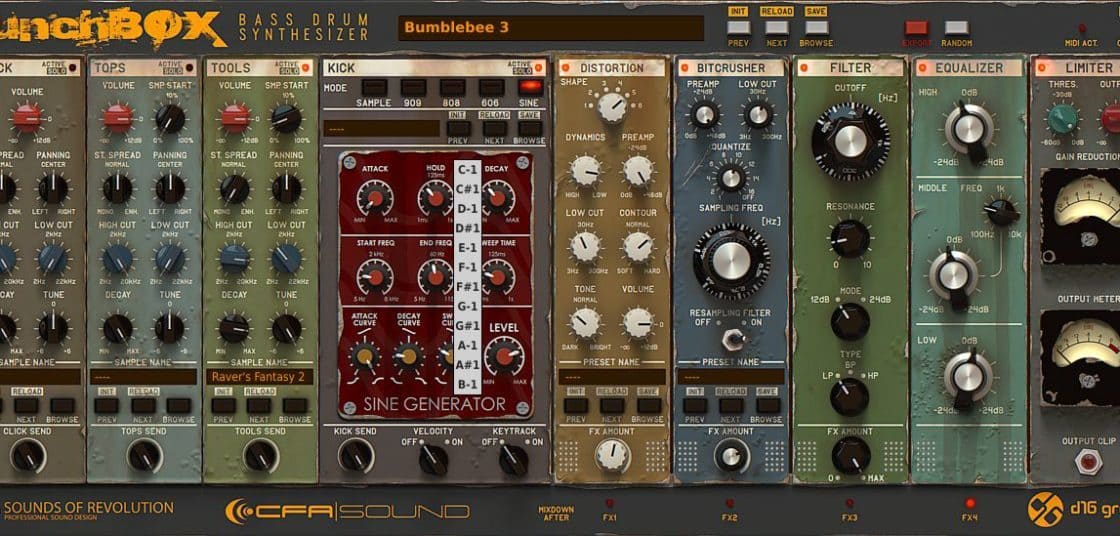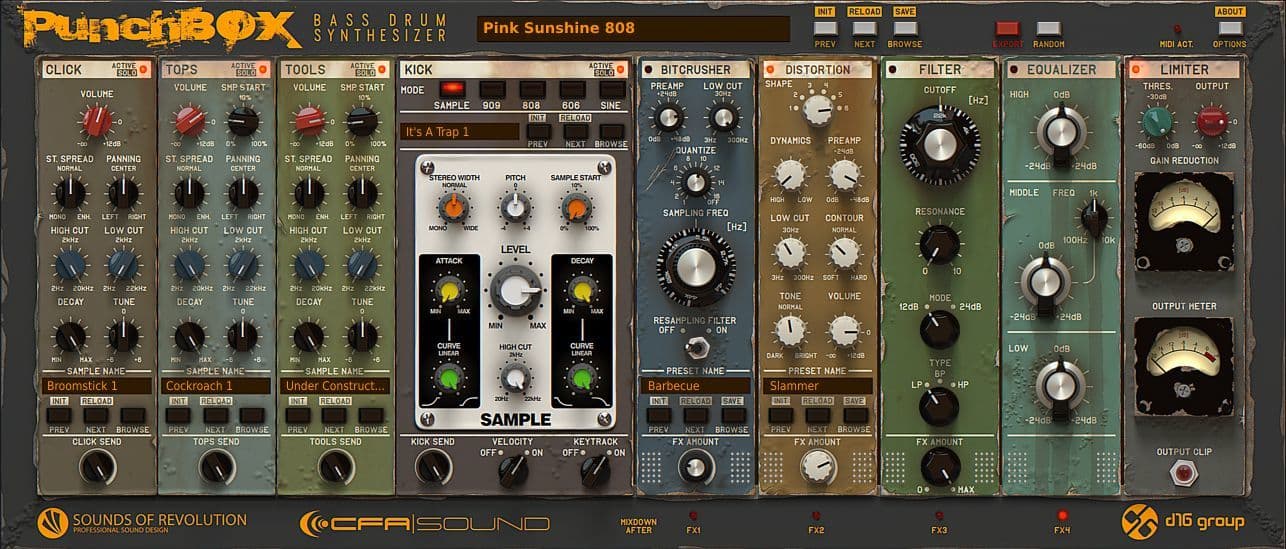Kick drums have definitely changed over the years. From basic acoustic kick drums, they evolved into electronic kicks made with analog synthesizers, and more recently into hybrid kicks which are assembled from multiple sampled/synthesized layers and heavily compressed. This is where versatile kick drum synthesizers such as D16 Group’s new PunchBOX plugin come into play.
PunchBOX is a complete toolkit for making contemporary layered kicks using synthesis, sampling and effects, although the instrument can be used to create those pure old school analog kicks as well. It is available for both Windows and Mac platforms, in both 32-bit and 64-bit versions.
Layers
There are four generator modules in Punchbox. Let’s start with the Kick module, which is basically the heart of the beast. It includes five different modes: 606, 808, 909, Sample and Sine. The Roland emulation modules are based on D16’s well known drum machine plugins – Nepheton, Drumazon and Nithonat. They emulate the vintage hardware with the same exact control knobs and parameter ranges that are available in the original instruments. There’s no circuit bending emulation, or extending the parameters beyond what the originals could do. Sine is a more flexible kick synthesizer, with a total of ten knobs controlling a sweeping sine wave and its envelope. Sample is a simple kick-specific sampler which loads a single sample.
The other three generators (Click, Tops and Tools) are all sample-based. The real difference between them is that they load different sample types – Click provides very short bursts of sound (and has one less control knob), Tops has somewhat longer sounds with a good deal of high frequency content (hi-hats, claps, pings etc.), and Tools is all about longer sounds with more midrange content, including some weird industrial-sounding noises. All of this allows the user to create anything from simple single-layer kick drums to complex multi-layered kicks and even some experimental noises and impact sound effects. About the only type of kick that can’t be made here is a realistic, naturally responsive acoustic kick drum (which would require velocity layers and round robins).
By default, all the layers ignore incoming MIDI pitch and velocity information, but velocity and pitch tracking can be switched on. Velocity tracking affects all four generators together and only affects the volume, meaning that softer hits don’t sound darker as they would on a physical acoustic kick drum. Pitch tracking only affects the kick module, which means that you can play basslines on an 808 bass drum (or a different tuned kick for that matter) while keeping the initial click unpitched. This doesn’t work quite well with some of the Tops and Tools samples that are also clearly pitched, but as long as you avoid those combinations it sounds much better than using 808s in a typical sampler. A standard sampler changes the pitch of all layers and makes the attack flabbier on lower notes. If your source kick is tuned to a note other than C (which 808s usually aren’t – the pitch range of the kick tail on a TR-808 goes only from about E to A), you’ll have to transpose your basslines, but it’s still much easier to play melodies with tuned kicks (or toms) in PunchBOX than with any other drum plugin I’ve used.
You can import your own samples into any of the modules, too, and layer them with whatever else you want to. So, any favorite samples of hardware drum machine kicks, or percussive sounds exported from any other synth, higher sounds for layering, toms… it’s completely up to you. PunchBOX can also load samples that were exported from itself, for those times when you want to get really crazy and make a kick with more than four layers.
Layering kicks with higher percussive sounds is actually very retro, by the way. If you look at some very early kick drums from the 1920s, they often included a small cymbal attached to the beater head. In other words, including a hi-hat layer in a kick drum is a lot more traditional than many of us realize.
Processing
PunchBOX also includes five built-in effects. These are: Bitcrusher, Distortion, Filter, Equalizer and Limiter. The distortion is great for making saturated kicks and seems specialized for distorting bass heavy sounds – it’s good at letting the low end come through unscathed while saturating the highs. The bitcrusher can get even nastier, and combined they can make very distorted hardcore or hardstyle kicks, which sound convincing to me, although I’m not a hardstyle producer. The filter is a typical resonant multimode filter. I haven’t found myself using it all that much except to sometimes remove shrill highs created by the bitcrusher at extreme settings. The equalizer and limiter don’t offer anything special in terms of features, but they’re both very useful for shaping the tone and shape of the kick.
The limiter is always last in the chain, however the other four effects can be routed in many different ways. For starters, they can easily be placed in a different order via drag and drop. Each generator has a send knob which controls how much of its signal skips the FX section goes straight to the limiter, and it’s also possible to have these skip only some of the other four effects. The distortion and bitcrusher also have their own wet/dry controls, making the entire FX section very well thought-out and flexible.
In Use
PunchBOX is a complex instrument, however the complexity is managed well. Each module has its own batch of presets, for example, which can result in significant time saving when building new kicks from scratch. Even though some of the controls need to be right-clicked or CTRL-clicked to access some functions (such as tuning the sine kick tail to a specific note, or saving a preset), the user interface is still not hard to use. PunchBOX is clearly focused on making good sounding layered kicks, so even though it is a complex and deep instrument, it is much more similar to a deep well than a vast jungle (if you catch my drift).
The GUI is painstakingly designed to look like an old piece of hardware, complete with grungy details such as paint peeling off in spots, stains, shadows, etc. It’s not the most functionally efficient interface in the world, but it sure is very nice to look at. The sound designers who contributed the samples and presets (Sounds Of Revolution and CFA-Sound) also have their names listed on the front panel, which, considering the amount of work that went into this (over 1,000 individual samples between the four generator modules, and over 800 presets), is certainly well deserved.
PunchBOX does use a fair bit of CPU to run (between 8% and 13% on my machine, depending on the number of modules used), but that’s not too bad considering the fact that you are unlikely to need multiple instances of it in a project. If you do want to save this CPU, however, the interface provides a handy Export button – it exports the current settings to a WAV file which you can then load in any sampler. This is a great option if you use one kick sound throughout a track (which is how kicks are normally used, after all) and don’t need to automate any of the parameters or use pitch tracking. I tend to synthesize kicks a lot, using either dedicated kick synths or drum machines, and while PunchBOX offers plenty more features than anything else I’ve used, the Export button has to be my favorite workflow feature. It really does make life a lot easier.
Summary
PunchBOX by D16 Group is a very complete toolkit for making modern kick drum sounds. It can give you anything from punchy analog style kicks to heavily layered house kicks, trap 808s, pitched 808 basslines, and even distorted industrial and hardcore kicks.
More info: PunchBOX ($89)
D16 PunchBOX Review
PunchBOX can give you anything from punchy analog style kicks to heavily layered house kicks, trap 808s, and even distorted industrial and hardcore kicks. Sure, it may be considered overkill for a lot of producers, but overkill rarely sounds this awesome.
-
Features10
-
Wokflow9
-
Performance9
-
Design9
-
Sound10
-
Pricing8




15 Comments
Toaster
onI’m IN :)
blip
onin :)
Schall & Rauch
oncome in and find out :)
Paree Katti
onI’m in
Adam Bialy
onI’m in
DaveMilla
onI’m in
Sancho
onWow. Nice plugin!
Brent
onAwesome! IN!
Perry Staltic
onGood review!
myossound
onGood luck everyone!
Perry Staltic
onI’m in, too…
Flo
onDamn! that looks really cool.
Kinono
onGood luck everyone!
c--Kri
onAmazing ex-soviet look, after the slick-modern look of the Antresol series and the hyper realistic design of the synths! Bravo D16.
D. Smolken
onHa, ex-Soviet! That’s a great way to put it!